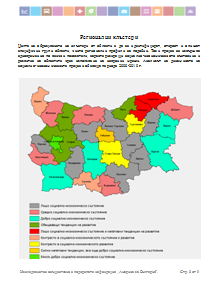Materials from the Press Conference
 Materials of the press conference, dedicated to the survey
Materials of the press conference, dedicated to the survey
We present you the materials which were handed out at the press conference, dedicated to the presentation of “Regional Profiles: Indicators for Development 2012”.
In these materials you can find information on the basic results of the analyses, conducted as part of the project, as well as IME’s recommendations for improvement of regional competiveness.
- The handout is available in pdf as well as docx format.
- The presentation used to present the project is available in pdf format.
- The districts’ performance grades in each of the 8 categories – economy, infrastructure, business climate, education, etc. are available here.
General conclusions:
- Until 2008, all districts demonstrated growth, but the rich ones developed faster than the poor ones; i.e. the gap between them increased and a group of regions that developed much faster than the others emerged;
- The gap has increased in the period of economic boom as well as in the period of crisis;
- The number of districts with poor socioeconomic profiles or showing negative trends is much bigger than the number of those with good socioeconomic profiles and positive trends;
- Demographic developments have an extremely strong – and usually negative – impact on the economic development of the regions;
- The high sense of security and the good quality of the environment increase personal satisfaction with life, while work conditions, income levels and the quality of infrastructure bring dissatisfaction;
- In spite of rather prolonged negative developments in the poorest regions, the majority of the population in them features rather low mobility;
- Proximity to Sofia (the capital) doesn’t have a singular effect on all the neighboring regions and does not automatically bring any advantage;
- The central government still plays a major role in local policies; this can be attributed to the unwillingness to delegate more powers to the local authorities;
- Even though local policies are restricted by law, they can have a paramount impact on the living conditions and business environment on regional level;
- Data is extremely scarce on a regional level, and sometimes its quality is questionable, which casts doubt on the ability of the government (both central and local) to take informed decisions.
Recommendations:
- A policy cannot have the same effect on all regions, therefore a higher degree of decentralization of the decision-making process is necessary;
- Real financial independence of the regions is needed; this will allow for differentiated local policies;
- Parliament should not be able to define the limits of local taxes – the decision and the responsibility for them should be delegated entirely to the local authorities;
- The regions should benefit from economic development – i.e. they should be entitled to a part of the revenues from as many taxes as possible, especially those connected with local economic activity (for instance, a part of the revenue from VAT, income taxes, corporate profit taxes etc.);
- Powers of regional authorities with regard to raising revenues and allocating expenditures should be balanced in such a way that they can become more independent from central government transfers;
- Powers of municipal authorities regarding local economic and social policies should be increased.
For more information:
Desislava NikolovaChief economist 02/952 62 66 |
Petar GanevSenior Economist 02/952 62 66 |
Yavor AlexievEconomist 02/952 62 66 |

